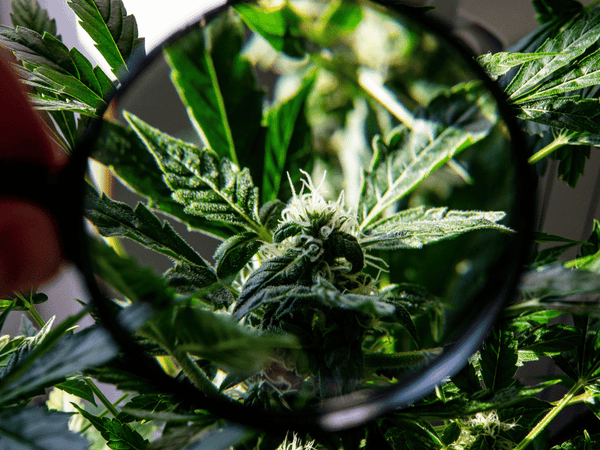In the ever-evolving landscape of cannabis products, two compounds have emerged into the spotlight: HHC (hexahydrocannabinol) and THC (tetrahydrocannabinol). As consumers navigate the vast array of options available, understanding the nuances between these compounds is crucial for making informed choices about their cannabis experience.
Although THC has long been acknowledged as the main psychoactive ingredient in cannabis, HHC has recently drawn interest due to possible parallels and distinctions with THC. In this article, we delve into the intricate world of cannabinoids, exploring the distinct characteristics of HHC and THC as well as their shared traits.
From their chemical structures to their effects on the mind and body, we'll unravel the mysteries surrounding HHC and THC, shedding light on their unique properties and potential benefits. Additionally, we'll address the legal landscape surrounding these compounds and provide insights into the implications for consumers.
Whether you're a seasoned cannabis enthusiast or a curious newcomer, this exploration of HHC versus THC aims to empower you with the knowledge needed to navigate the diverse landscape of cannabis products responsibly and confidently. Let's embark on this journey of discovery together, as we unravel the complexities of HHC and THC.
What is HHC?

HHC, or Hexahydrocannabinol, is a lesser-known cannabinoid that has recently piqued the interest of researchers and consumers alike. HHC is an analog of the THC molecule, with a similar but slightly altered chemical arrangement, specifically with a hexahydrocannabinol ring instead of a double bond in its cyclohexyl ring.
As such, it contains more hydrogen atoms than THC and the hydroxyl (OH) group. These molecular changes give them different properties. Unlike THC, which is widely recognized for its intense psychoactive effects, HHC's properties and potential remain somewhat shrouded in mystery.
Definition And Background
HHC is a cannabinoid compound found in cannabis plants, smoking marijuana, though it occurs in marijuana plants in much lower concentrations compared to THC and CBD. Its chemical structure differs from that of THC and other cannabinoids, containing six hydrogen atoms instead of five in its molecular makeup.
Chemical Structure And Properties
The unique structure of HHC contributes to its distinct effects on the body's endocannabinoid system. While research is still in its early stages, scientists speculate that HHC may interact with cannabinoid receptors like THC, albeit with potentially different outcomes.
Potential Benefits And Effects
Limited studies suggest that HHC may possess therapeutic properties similar to THC, including analgesic and anti-inflammatory effects. However, further research is needed to fully understand its potential benefits and any associated risks.
Legal Status And Regulations
Is HHC legal? Due to its relatively recent emergence, HHC's legal status varies across jurisdictions. In some regions, it falls under the umbrella of traditional cannabis and regulations, while in others, it may exist in a legal gray area. As such, consumers should be mindful of local laws and regulations when considering HHC products.
What is THC?

THC, or Tetrahydrocannabinol, stands as one of the most well-known and researched cannabinoids found in the cannabis plant. Its psychoactive properties have made it a focal point of both recreational and medicinal cannabis use.
Definition And Origins
THC was first isolated and identified in the 1960s by Israeli scientist Dr. Raphael Mechoulam. It is primarily derived from the resin of the cannabis plant, specifically the glandular trichomes found on the flowers and leaves.
Chemical Structure And Similarities/Differences with HHC
Structurally, THC shares similarities with HHC, both being cannabinoids with a cyclohexane ring. However, THC contains five more hydrogen atoms in its molecular structure, distinguishing it from HHC. This subtle difference contributes to variations in their effects on the endocannabinoid system.
Known Effects On The Body And Mind
THC is renowned for its psychoactive properties, which result in alterations in mood, perception, and cognition when consumed. It achieves these effects by binding to cannabinoid receptors in the brain, particularly the CB1 receptors, leading to the release of neurotransmitters such as dopamine and serotonin.
Legal Status And Regulations
The legal status of THC varies significantly across jurisdictions. In some regions, it is classified as a controlled substance due to its psychoactive effects and potential for abuse. However, in others, it may be available for medical or recreational use under specific regulations.
Alive Market 1:1 CBD+THC Gummies | 10mg THC + 10mg Full Spectrum CBD
Introducing Alive Market's latest innovation: the 1:1 CBD+THC Gummies, meticulously crafted to offer the perfect balance of THC and full-spectrum CBD. Each gummy contains precisely 10mg of THC and 10mg of full-spectrum CBD, ensuring a harmonious experience with every bite. These gummies are the epitome of quality and consistency, designed to provide users with a reliable and enjoyable way to incorporate cannabinoids into their wellness routine.
At Alive Market, we understand the importance of using premium ingredients to create products that our customers can trust. That's why our 1:1 CBD+THC Gummies are made with the finest quality THC and full-spectrum CBD extracts, sourced from reputable growers who adhere to the highest standards of cultivation. With a commitment to purity and potency, we ensure that each gummy delivers a consistent dose of cannabinoids, allowing users to experience the full therapeutic benefits with every serving.
Differences Between HHC and THC
While HHC and THC share some similarities as cannabinoids found in cannabis, they also exhibit distinct characteristics that set them apart. Understanding these differences is essential for consumers seeking to make informed choices about their cannabis consumption.
Chemical Structure and Composition
The primary difference between HHC and THC lies in their chemical structures. HHC contains six hydrogen atoms in its molecular makeup, whereas THC contains five. This variance in structure contributes to differences in their interactions with the endocannabinoid system and subsequent effects on the body and mind.
Psychoactive Effects
THC is renowned for its psychoactive properties, producing the euphoric "high" commonly associated with cannabis consumption. In contrast, HHC's psychoactive effects are less well-understood and may vary from person to person. Some users report experiencing mild euphoria and relaxation, while others may notice little to no psychoactive effects.
Therapeutic Potential
While THC is recognized for its potential therapeutic benefits alone, including pain relief, nausea reduction, and appetite stimulation, the therapeutic potential of HHC remains relatively unexplored. Limited research suggests that HHC may possess similar medicinal properties to THC, but further studies are needed to confirm its efficacy and safety.
Legality and Accessibility
The legal status of HHC and THC varies across jurisdictions and is subject to change as cannabis laws evolve. THC's psychoactive nature often results in stricter regulations, particularly in regions where cannabis remains illegal. In contrast, HHC's legal status may be less defined due to its novelty and limited research.
Overall, while both HHC and THC are cannabinoids found in cannabis, they exhibit unique characteristics that differentiate them from one another. By understanding these differences, consumers can make informed decisions about which cannabinoid compounds align with their preferences and wellness goals.
Similarities Between HHC and THC
Despite their differences, HHC and THC share several similarities that underscore their common origins as cannabinoids derived from the cannabis and hemp plants themselves. Exploring these shared traits provides valuable insights into other cannabinoids and their potential effects and applications.
Shared Chemical Properties
Both HHC and THC belong to the class of cannabinoids, sharing similar chemical properties that enable them to interact with the endocannabinoid system in the brain cells and body. Their molecular structures feature aromatic rings and hydrocarbon chains, allowing for binding with cannabinoid receptors.
Potential Medicinal Uses
Like THC, HHC exhibits potential medicinal properties that warrant further investigation. Preliminary research suggests that both compounds may offer therapeutic benefits such as pain relief, anti-inflammatory effects, and appetite stimulation. However, additional studies are needed to elucidate their specific mechanisms of action and therapeutic potential.
Similarities In Consumption Methods
HHC and THC can be consumed through various methods, including smoking, vaporization, ingestion, and topical application. Both compounds are commonly found in cannabis products such as flowers, concentrates, edibles, and topicals, providing consumers with diverse options for consumption.
Impact On The Endocannabinoid System
Both HHC and THC interact with the endocannabinoid system, a complex network of receptors and neurotransmitters involved in regulating various physiological processes. By binding to cannabinoid receptors (CB1 and CB2), HHC and THC modulate neurotransmitter release, leading to alterations in mood, pain perception, appetite, and other functions of the central nervous system.
While HHC and THC possess distinct characteristics, their shared traits underscore the interconnected nature of cannabinoids and their potential contributions to human health and wellness. As research continues to unravel the complexities of the endocannabinoid system, consumers can look forward to gaining a deeper understanding of how these compounds interact with the body and mind.
Potential Risks and Side Effects
As with any cannabis-derived compound, both HHC and THC carry potential risks and side effects that consumers should be aware of before using products containing these cannabinoids. While some effects may be similar between the two compounds, others may differ due to variations in their chemical structures and interactions with the body.
Known risks associated with THC consumption
Psychoactive effects: THC's psychoactive properties can lead to alterations in mood, perception, and cognition, which may be undesirable for some individuals.
Impaired cognitive function: High doses of THC have been associated with temporary impairments in memory, concentration, and judgment, particularly in inexperienced users.
Increased heart rate: THC consumption may cause a temporary increase in heart rate, which can be concerning for individuals with preexisting cardiovascular conditions.
Potential for addiction: Chronic, heavy use of THC-containing products may lead to dependence and withdrawal symptoms in some individuals.
Emerging research on potential risks of HHC
Limited research: Due to its novelty, there is a scarcity of scientific studies examining the potential risks and side effects of HHC consumption.
Unknown long-term effects: The long-term consequences of regular HHC use remain unclear, as there is insufficient data available to assess its safety profile over extended periods.
Variability in effects: Individual responses to HHC may vary, and some users may experience adverse physical reactions such as anxiety, paranoia, or discomfort.
Safety considerations for consumers
Start low, go slow

When trying HHC or THC-containing products for the first time, it's advisable to start with a low dose and gradually increase as needed to gauge tolerance and minimize the risk of adverse effects.
Know your limits

Understanding your tolerance and sensitivity to cannabinoids can help prevent overconsumption and mitigate potential risks.
Seek medical advice

Individuals with underlying health conditions or concerns should consult with a healthcare professional before using cannabis products, especially those containing psychoactive compounds like THC or HHC.
Be mindful of product quality

Choose reputable brands and products that undergo rigorous testing for potency, purity, and contaminants to ensure safety and efficacy.
Consumer Considerations and Recommendations
Navigating the diverse landscape of cannabis products containing HHC and THC requires careful consideration and informed decision-making on the part of consumers. By taking into account various factors and following practical recommendations, individuals can enhance their cannabis experience while minimizing potential risks.
Factors to consider when choosing between HHC and THC products
Desired effects: Determine whether you're seeking psychoactive effects (e.g., euphoria, relaxation) associated with THC or exploring the potential therapeutic and medical benefits of HHC.
Tolerance and sensitivity: Assess your individual tolerance to cannabinoids and consider starting with lower doses, especially if you're new to cannabis or have limited experience.
Legal considerations: Familiarize yourself with local laws and regulations regarding the sale, possession, and use of cannabis products containing HHC and THC to ensure compliance.
Product availability: Research the availability of HHC and THC products in your area and explore options from reputable dispensaries or licensed retailers.
Dosage guidelines and responsible consumption practices
Start low: Begin with a low dose of HHC or THC and gradually increase as needed, allowing time to assess the effects before consuming more.
Know your limits: Monitor your consumption and be mindful of your tolerance level to avoid overconsumption and potential adverse effects.
Consider alternative consumption methods: Explore different methods of consuming HHC and THC, such as vaping, edibles, or topicals, to find what works best for you.
Avoid mixing substances: Refrain from combining HHC or THC with alcohol or other substances that may potentiate or alter their effects, increasing the risk of adverse reactions.
Seeking advice from healthcare professionals
Consult with a healthcare provider: Discuss any underlying health conditions or concerns with a qualified healthcare professional before using cannabis products, particularly if you're pregnant, nursing, or have a history of mental health disorders.
Seek guidance on dosage and safety: Healthcare professionals can provide personalized recommendations on dosage, consumption methods, and potential interactions with medications to ensure the safe and effective use of HHC and THC.
Importance of understanding individual tolerance and preferences
Experiment responsibly: Take a cautious and methodical approach to experimenting with HHC and THC products, paying attention to how different doses and consumption methods affect your experience.
Listen to your body: Pay attention to your body's signals and adjust your consumption accordingly, respecting your tolerance and preferences.
Keep a journal: Keep track of your experiences with different HHC and THC products, noting dosage, effects, and any adverse reactions to inform future consumption decisions.
Conclusion
In conclusion, the comparison between HHC and THC provides valuable insights into the diverse landscape of cannabis products and their potential effects on consumers. While both compounds share similarities as cannabinoids derived from both the cannabis plant and hemp plant, they also exhibit distinct characteristics that influence their interactions with the body's cannabinoid receptors and mind.
Throughout this exploration, we've examined the differences and similarities between HHC and THC, from their chemical structures to their potential therapeutic applications and legal considerations. While THC remains the more widely studied and recognized cannabinoid, HHC's emergence offers intriguing possibilities for further research and product development.
For consumers, understanding the nuances between HHC and THC is essential for making informed decisions about cannabis consumption. By considering factors such as desired effects, individual tolerance, legal regulations, and responsible consumption practices, individuals can enhance their cannabis experience while minimizing potential risks.
As the landscape of medical cannabis itself continues to evolve, ongoing research and education are critical for advancing our understanding of cannabinoids like HHC and THC and their impact on human health and wellness. By staying informed, practicing responsible consumption, and seeking guidance from healthcare professionals, consumers can navigate the complexities of cannabis with confidence and empowerment.
In closing, the journey of exploration into HHC vs. THC underscores the dynamic nature of cannabis science and the importance of informed decision-making in maximizing the benefits of cannabis while prioritizing safety and well-being. As we continue to unravel the mysteries of how cannabinoids interact, let us embrace curiosity, responsibility, and respect for the plant's potential to enhance lives.


